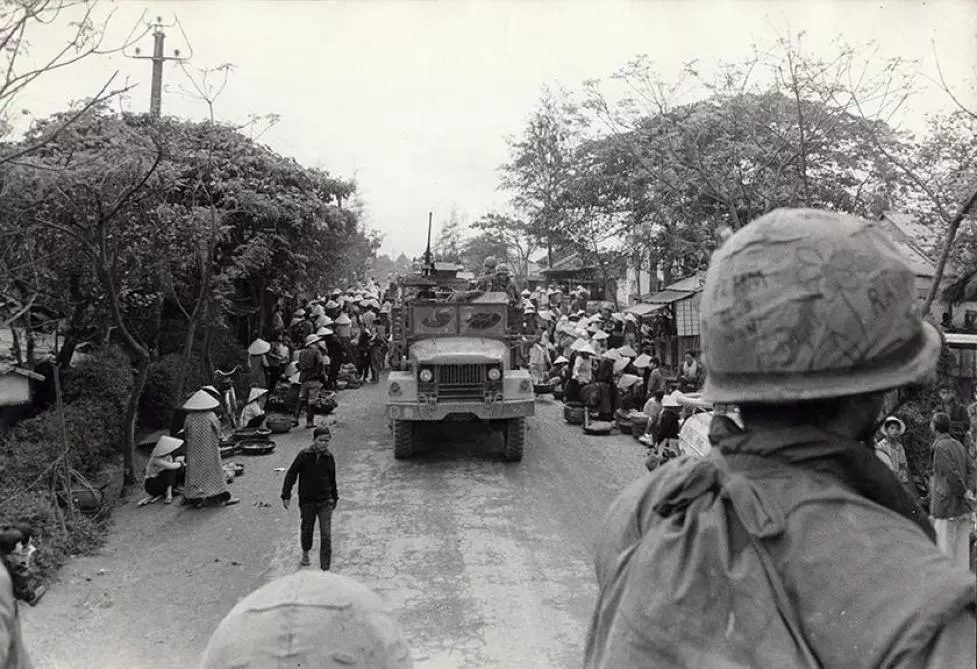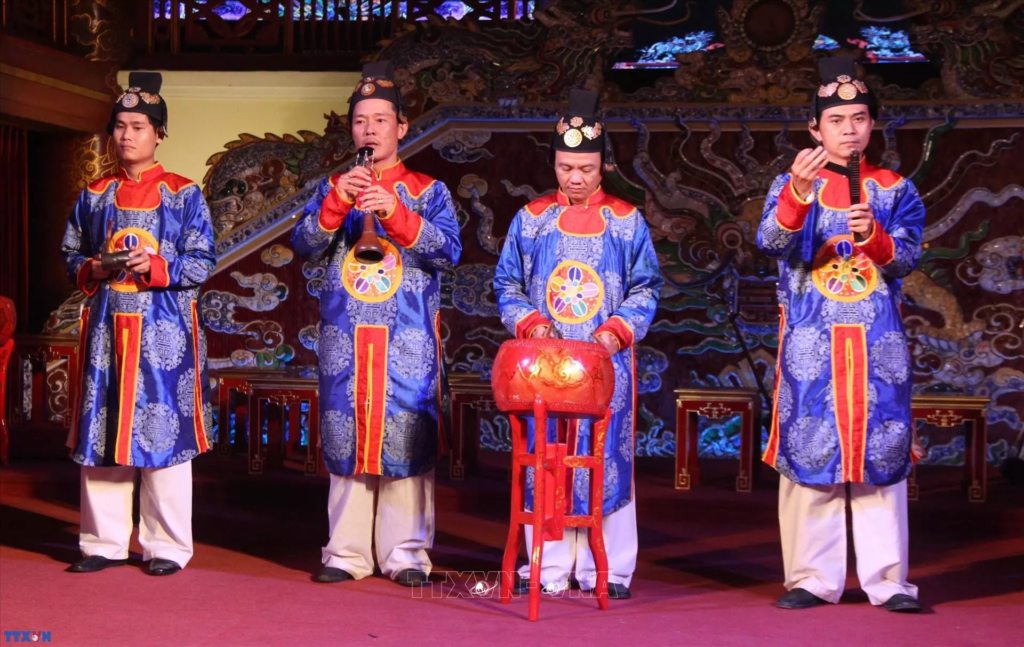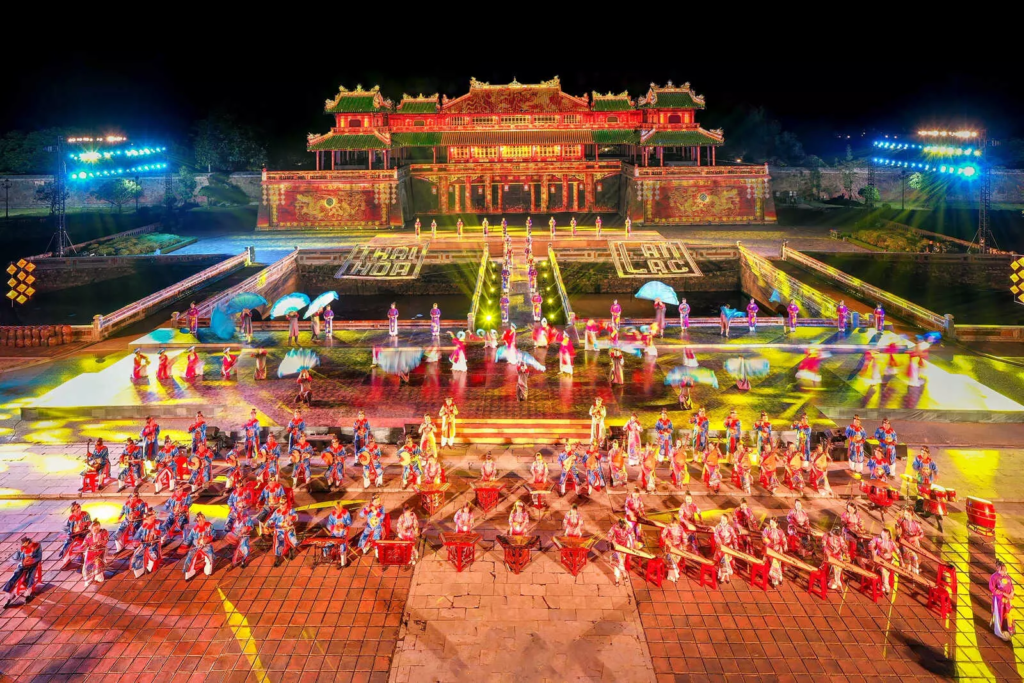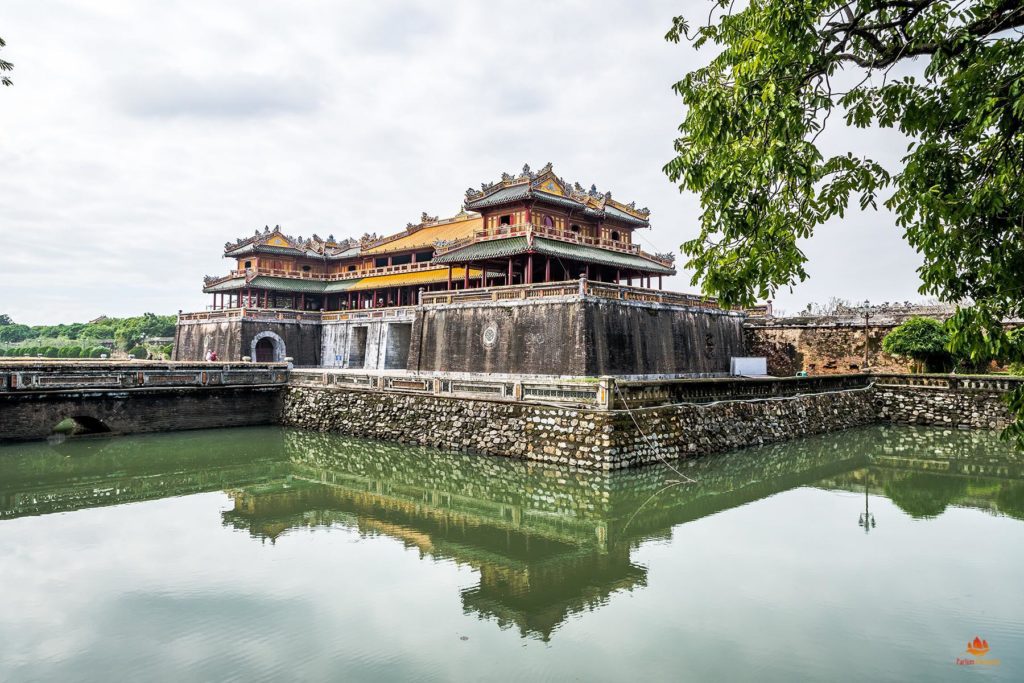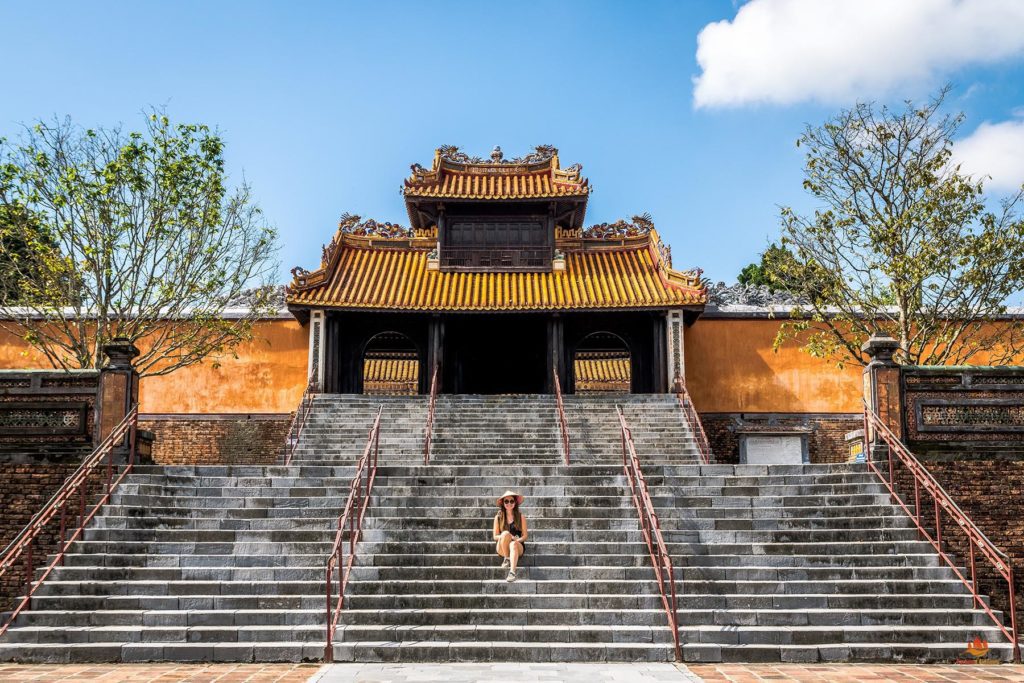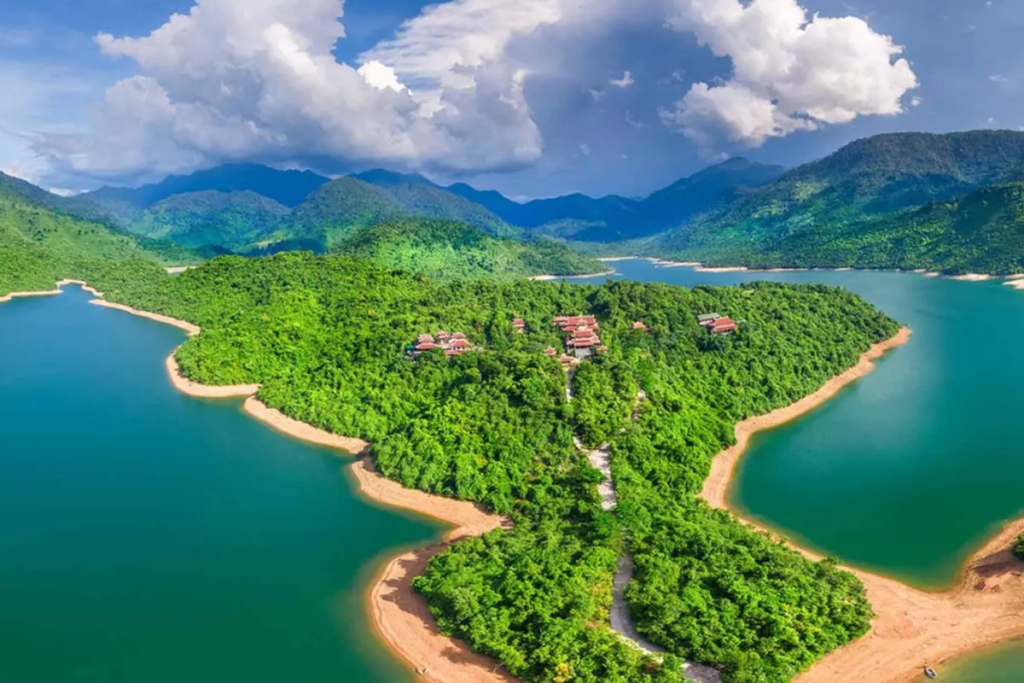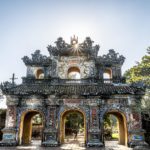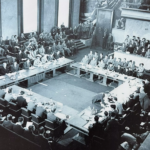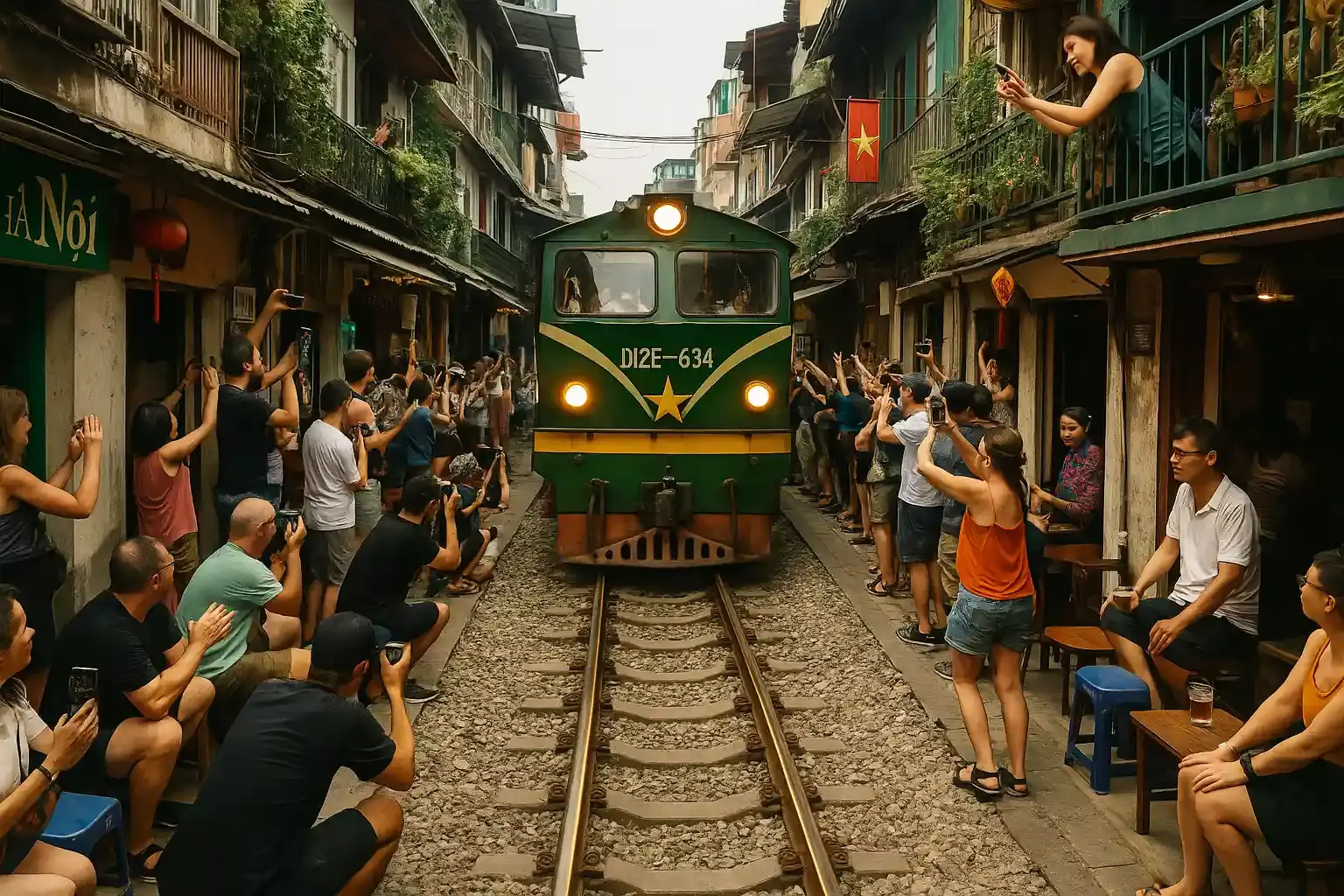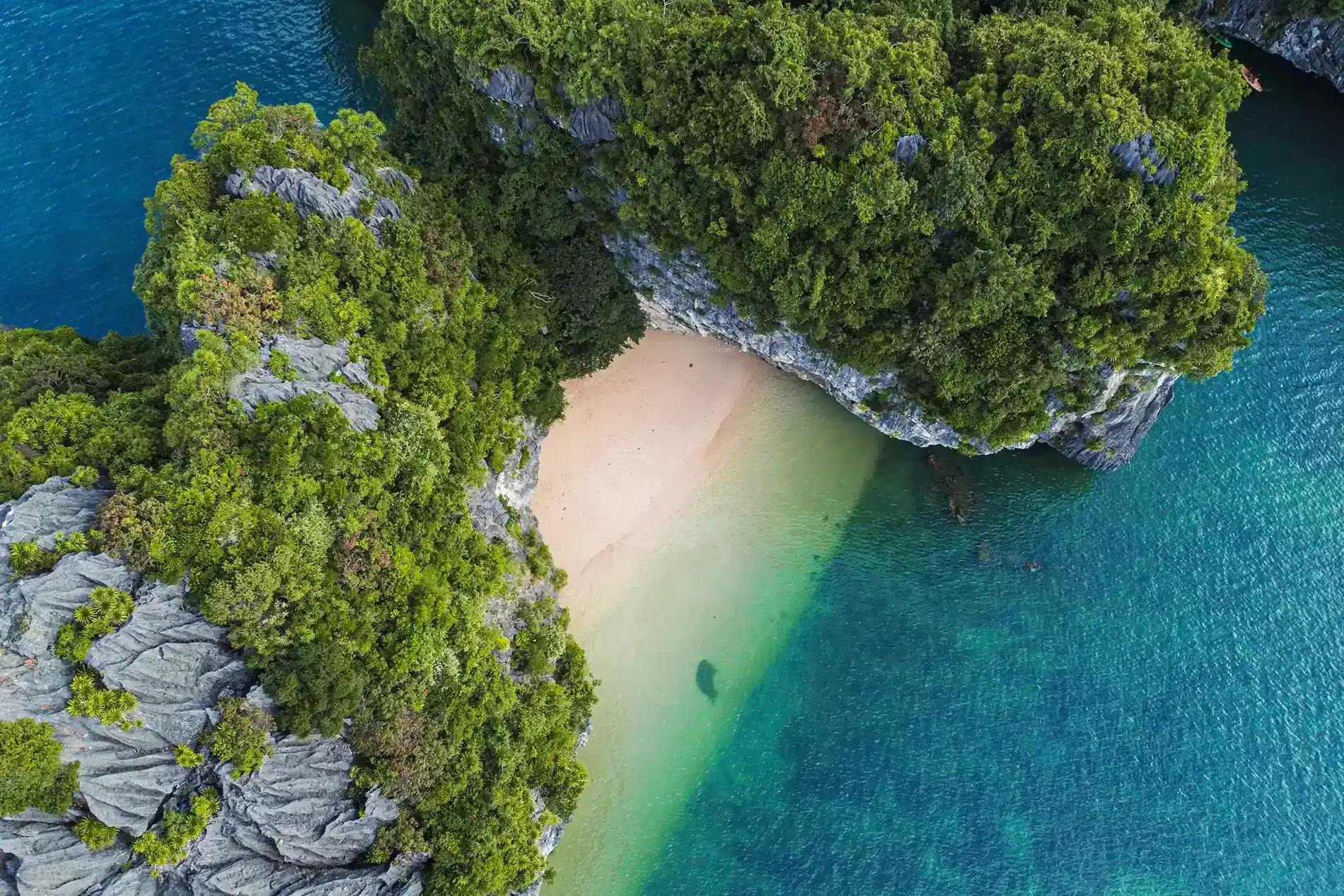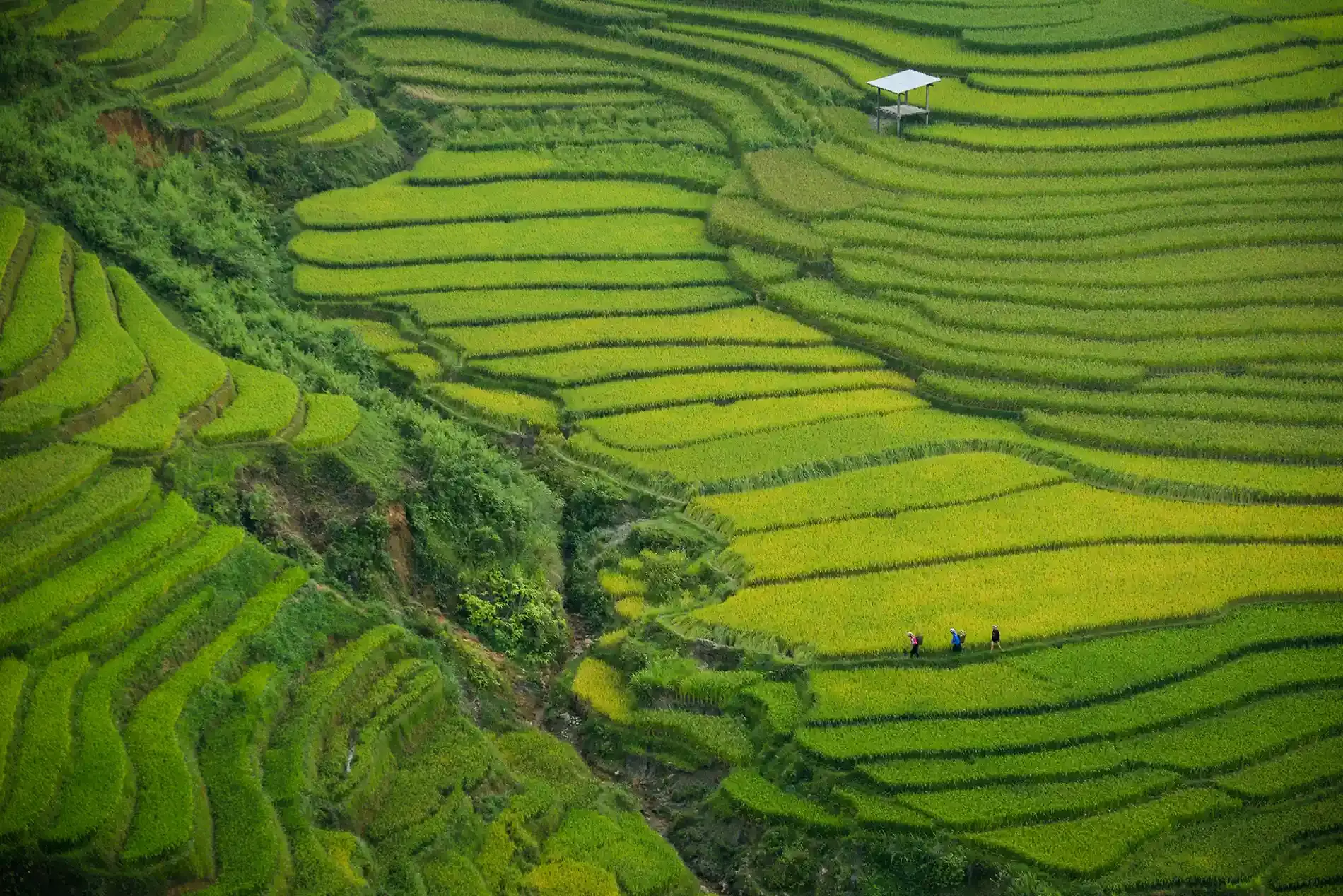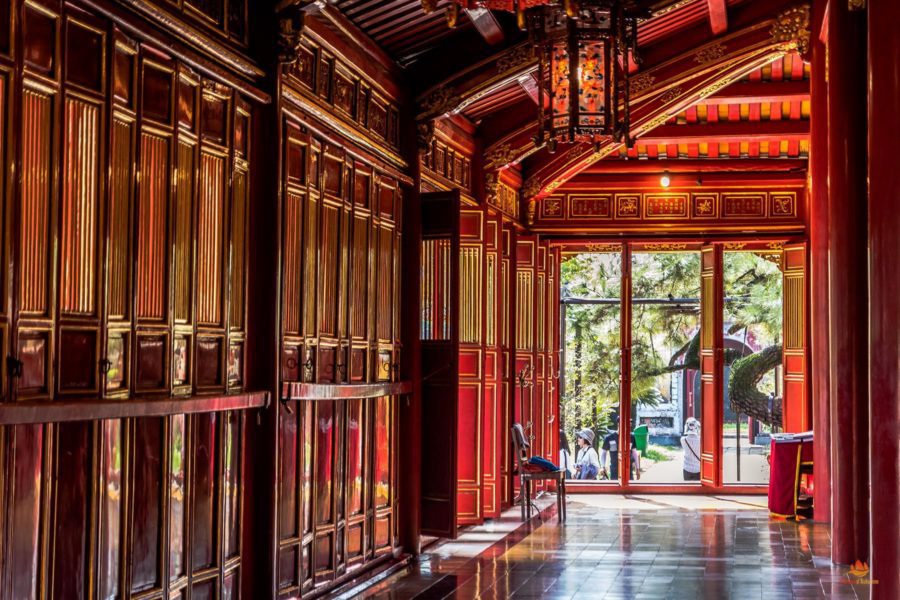
Complete guide to Hue, the ancient imperial capital of Vietnam
Hue, located in central Vietnam, is a city steeped in history and culture. As the former imperial capital of the Nguyen dynasty, Hue is a treasure trove of historical monuments, temples, pagodas, and royal tombs. The city is renowned for its elegant architecture, artistic traditions, and refined cuisine.
This article delves into the rich history, must-see tourist sites, unique culture, and the picturesque surroundings of Hue.
Table des matières de l'article
History of Hue
The Nguyen dynasty
The legend of Emperor Gia Long and the foundation of Hue
Emperor Gia Long, whose real name was Nguyen Phuc Anh, is an iconic figure in the history of Hue. His rise to power was marked by trials and struggles. In 1789, after a series of bloody battles against the Tây Sơn, he succeeded in unifying the country and establishing the Nguyen dynasty. According to legend, Gia Long chose Hue as the capital after consulting an oracle who predicted that this region would bring prosperity and stability to his reign. To bring this vision to life, he built the Imperial City, a symbol of the power and grandeur of his dynasty.
Emperor Minh Mang and his reformist reign
Emperor Minh Mang, the son of Gia Long, is known for his administrative and cultural reforms. His reign, from 1820 to 1841, was marked by the centralization of power and the consolidation of the Vietnamese state. Minh Mang is also famous for his opposition to foreign influences and his efforts to preserve Vietnamese cultural identity. An interesting anecdote tells that Minh Mang, a great lover of poetry and literature, spent hours composing poems and organizing poetry competitions at the imperial court.
The builder emperors
Under the Nguyen dynasty, Hue was transformed into a vibrant center of culture and power. The Nguyen emperors constructed the Imperial City, inspired by the Forbidden City in Beijing, which became the heart of the city. This period also saw the construction of numerous temples, pagodas, and royal tombs, each reflecting the grandeur and aesthetics of the era. The Nguyen dynasty ruled until 1945, marking over 140 years of imperial influence.
The scholars emperors
The emperors of the Nguyen dynasty were not only political and military leaders but also scholars with a deep passion for poetry and the arts. The role of literature in their lives and reign was central, reflecting the importance of culture and scholarship at the imperial court of Hue. This literary tradition helped make the Imperial City a major intellectual and artistic hub of Vietnam.
Emperor Minh Mang (reigned 1820-1841) is particularly renowned for his contribution to Vietnamese poetry. Known for his administrative rigor and reforms, Minh Mang was also a prolific poet. He wrote poems on a variety of themes, ranging from politics to nature and human relationships. His writings reflect a profound knowledge of Chinese and Vietnamese classics, as well as a personal dedication to the poetic arts. Minh Mang regularly organized poetry contests at the court, encouraging scholars and intellectuals to showcase their literary talents.
Under the Nguyen dynasty, the Hue court became a vibrant center of culture and literature. The emperors promoted education and the development of the arts, attracting poets, scholars, and artists from across the country. Literary academies and poetry societies flourished, making Hue a dynamic center for the production and dissemination of culture. Poetry contests, public readings, and literary debates were regular events that celebrated the importance of literature in court life.
The Nguyen emperors’ emphasis on poetry and the arts had a lasting impact on Vietnamese culture. Literature and poetry became pillars of national identity, influencing future generations of scholars and artists. The works of the emperors and poets of the Hue court continue to be studied and appreciated, bearing witness to the significance of the literary tradition in Vietnam’s history.
The Vietnam War
The Têt offensive : a decisive turning point
One of the most significant periods in the modern history of Hue is its role in the Vietnam War, particularly during the Tet Offensive in 1968. This offensive, launched by North Vietnamese forces and the Viet Cong, aimed to trigger a general uprising in the South and overthrow the South Vietnamese government. Hue, as a strategically located and historically significant city, quickly became one of the main battlegrounds of this offensive.
For more than three weeks, the city of Hue was the scene of intense and destructive fighting. North Vietnamese forces occupied the city, including the Imperial City, and were engaged in fierce battles with U.S. and South Vietnamese forces. This siege resulted in massive destruction of infrastructure and many historical monuments. The human toll was also considerable, with thousands of civilians killed or wounded, and many others displaced.
Têt offensive in the streets of Hue
The massacres of Hue
During the occupation of Hue, atrocities were committed by communist forces, including the mass executions of South Vietnamese officials, intellectuals, and civilians deemed sympathizers of the South Vietnamese government. These massacres had a profound impact on the local population and left an indelible mark on the city’s history. The mass graves discovered after the city was retaken by allied forces bear witness to the brutality of these events.
A dynasty in decline
By the time of the Vietnam War, the Nguyen dynasty no longer held the power it once wielded. Since the end of the monarchy in 1945, the Hue court had lost its political role and only held a symbolic function. However, members of the former court and their descendants retained some cultural and social influence in the region.
Emperors abdicate and their neutrality
Emperor Bao Dai, the last emperor of the Nguyen dynasty, abdicated in 1945 but remained an important symbolic figure. During the war, Bao Dai lived in exile in France, and his role was limited. The Hue court, stripped of its political power, did not play an active role in the conflict. However, some noble families in Hue were divided between supporting the South Vietnamese government and sympathizing with the Viet Cong, reflecting the complexities and internal divisions of the country during this tumultuous period.
Devastation and reconstruction
The Vietnam War, particularly the Tet Offensive, left Hue devastated. Intense fighting and bombings destroyed many historic buildings, including parts of the Imperial City. The destruction of civilian infrastructure and homes made Hue a war-torn city, requiring massive reconstruction efforts after the end of hostilities.
Impact on cultural heritage
The damage inflicted on the Imperial City and other historical monuments in Hue had a profound impact on Vietnam’s cultural heritage. The loss of these structures, some dating back centuries, represented an immeasurable loss for Vietnamese history and culture. Restoration efforts undertaken after the war, with the help of international organizations, have helped preserve and restore some of these treasures, but many of the damages remain irreversible.
Reconciliation and memory
The Vietnam War left deep scars not only on Hue’s infrastructure but also on its population. The memory of the massacres and destruction still haunts many of its residents. However, the resilience of the people and efforts towards reconciliation have helped the city rebuild. Today, Hue stands as a symbol not only of the tragedy of war but also of rebirth and peace.
Imperial city of Hue
Planification and initial construction (1802-1832)
Gia Long vision (1802-1820)
Emperor Gia Long, founder of the Nguyen dynasty, initiated the construction of the Imperial City of Hue in 1802, after consolidating his power and unifying Vietnam. Inspired by the Forbidden City in Beijing, Gia Long sought to create a powerful symbol of his reign and national unity. The planning of the city followed the principles of feng shui and Vietnamese geomancy, aiming to harmonize human structures with natural forces.
Minh Mang work (1820-1841)
Emperor Minh Mang, successor of Gia Long, continued the construction and expansion of the Imperial City. During his reign, several major structures were erected, including palaces, temples, and pavilions. Minh Mang paid particular attention to architectural and symbolic details, incorporating elements of Vietnamese and Confucian culture. The construction of the Imperial City mobilized thousands of workers and artisans, making Hue a vibrant center of activity and innovation.
The golden age of the Imperial City (1832-1883)
Cultural and political flourishing
During this period, the Imperial City reached its peak as the political, cultural, and religious center of Vietnam. The Nguyen emperors used the city to govern the country, organize state ceremonies, and receive foreign dignitaries. The Palace of Supreme Harmony, where the emperor held his official audiences, became the heart of imperial life. The court of Hue was renowned for its cultural richness, with poets, musicians, and scholars contributing to the intellectual brilliance of the Nguyen dynasty.
Royal tombs construction
At the same time, the Nguyen emperors built magnificent tombs along the Perfume River. These mausoleums, such as those of Tu Duc, Minh Mang, and Khai Dinh, are architectural masterpieces, combining landscape and structural elements. Each tomb reflects the personality and beliefs of the emperor for whom it was built, contributing to the region’s rich heritage.
Tomb of Tu Duc emperor, Hue
Period of crisis and decline (1883-1945)
Internal turmoil and colonial pressures
The second half of the 19th century was marked by internal unrest and increasing pressure from colonial powers, particularly France. Foreign influence and internal revolts gradually weakened the authority of the Nguyen emperors. The architecture of the Imperial City began to suffer from neglect and degradation. In 1885, French troops invaded Hue, looting the Imperial City and imposing their control over the Nguyen dynasty, which became largely symbolic.
Modernization and resistance
In the early 20th century, the emperors attempted to introduce reforms and modernize the country, but these efforts were often thwarted by the French colonial administration. Emperor Khai Dinh (1916-1925) adopted a more modern lifestyle, incorporating Western elements into his reign and the construction of his tomb. However, this modernization was seen by many as a loss of national and cultural identity.
The Vietnam War and its consequences (1945-1975)
Impact of the war
The Vietnam War (1955-1975) left an indelible mark on Hue and its Imperial City. In 1968, during the Tet Offensive, Hue became the scene of one of the bloodiest battles of the conflict. The Imperial City suffered heavy destruction: palaces, temples, and residences were damaged or destroyed. The war severely impacted the physical structure and historical integrity of the city.
Reconstruction and preservation
After the end of the war in 1975, efforts were made to reconstruct and preserve the Imperial City. The people of Hue, supported by national and international organizations, worked to restore the damaged monuments and preserve the city’s cultural heritage. In 1993, the Imperial City was designated as a UNESCO World Heritage Site, recognizing its historical and cultural significance and ensuring continued efforts for its protection and restoration.
Culture and tradition of Hue
As we have seen, Hue is a true treasure of culture and traditions. The city is known for its rich artistic heritage, colorful festivals, and refined cuisine. Let’s explore in more detail these unique aspects that make Hue a must-visit cultural destination.
Music and poetry
Nha Nhac : vietnamese court music
Nha Nhac,’ or Vietnamese court music, is one of the most iconic art forms of Hue. Recognized by UNESCO as an intangible cultural heritage of humanity, this music was once performed during royal ceremonies and imperial festivals. Nha Nhac uses traditional instruments such as the dan bau (monochord), dan nguyet (two-stringed lute), and bronze drums. This music is often accompanied by poetic songs that celebrate nature, love, and loyalty. Nha Nhac performances offer a fascinating glimpse into the cultural sophistication of the Hue court.
Nha hac performance in Hue
Poetry at the court of Hue
The emperors of the Nguyen dynasty, such as Minh Mang and Tu Duc, were passionate lovers of poetry. Poetry was an integral part of court life, with regular competitions and public readings. The poems composed during this time often reflected political concerns, personal emotions, and observations of nature. The poetic tradition of Hue left a lasting legacy in Vietnamese literature, influencing future generations of writers and poets.
Tradionnal festivals
The Hue Festival
The Hue Festival, held every two years, is the city’s largest cultural event. This festival celebrates Hue’s imperial heritage through a series of performances including music, dance, theater, and martial arts. Visitors can attend historical reenactments, religious processions, and art exhibitions. The festival attracts artists and visitors from around the world, turning the city into a vibrant stage for cultural celebration.
Show during the Festival of Hue
Têt : Vietnamese new year
Tet, or the Vietnamese New Year, is another major celebration enthusiastically observed in Hue. During this time, families gather to honor their ancestors, exchange well-wishes, and share festive meals. The streets of Hue come alive with vibrant markets, colorful decorations, and dragon parades. Traditional rituals, such as offering presentations and lion dances, are essential aspects of this festival, providing visitors with an authentic experience of Vietnamese culture.
Mid-autumn festival
The Mid-Autumn Festival, or Tết Trung Thu, is a celebration dedicated to children. During this festival, children carry colorful lanterns and take part in joyful parades through the streets. Families prepare mooncakes, fruits, and sweets, sharing these treats with their neighbors and friends. The Mid-Autumn Festival is an opportunity for the children of Hue to have fun and participate in traditional games, strengthening community and family bonds.
The culinary art of Hue
The dishes of Hue are among the most famous in Vietnam. Here are a few of them below.
Bun Bo Hue : the spicy noodle soup
Bun Bo Hue is one of the most famous dishes in Hue’s cuisine. This spicy beef noodle soup is made with a broth flavored with lemongrass, chili, and shrimp paste. The dish is often topped with slices of beef, pork trotters, cubes of pig’s blood, and thick rice noodles. Bun Bo Hue is a true feast for the taste buds, offering a perfect balance of salty, spicy, and umami flavors.
Bún bò Hue
Banh Beo : steamed rice cakes
Banh Beo are small steamed rice cakes topped with dried shrimp, fried shallots, and scallions. They are served with a sauce made from nuoc mam (fish sauce) and vinegar, adding a touch of acidity that balances the sweetness of the cakes. Banh Beo are often enjoyed as a snack or side dish and are particularly loved for their soft texture and delicate flavor.
Banh Beo
Com Hen : clam rice
Com Hen is a dish of rice with clams, served with vegetables, herbs, and spices. This dish is typically made with fresh clams from the Perfume River, cooked with rice and seasoned with chili, ginger, and fish sauce. Com Hen is known for its unique combination of flavors and textures, offering an authentic culinary experience from Hue.
Arts and crafts
The making of conical hats
Conical hats, or ‘non la,’ are an iconic symbol of Vietnamese culture. In Hue, the craft of making these hats is an art passed down through generations. Artisans in Hue use carefully selected palm leaves and meticulous weaving techniques to create lightweight and durable hats. The conical hats from Hue are often adorned with artistic designs, adding a touch of elegance to their functionality.
Embroidery and silk
Embroidery is another traditional art in Hue, with a long history of creating exquisite clothing and accessories. Hue’s embroiderers use colorful silk threads to create intricate patterns on silk fabrics, often depicting scenes of nature, flowers, and animals. The silk products from Hue, such as scarves, clothing, and embroidered paintings, are prized for their beauty and high-quality craftsmanship.
Must-visit sites
The Imperial City (Dai Noi)
The Imperial City of Hue, a UNESCO World Heritage Site, is undoubtedly the city’s main attraction. This vast fortified complex is surrounded by thick walls and a wide moat, protecting a collection of palaces, temples, gardens, and royal residences.
Notable sites to visit include:
# The Noon Gate (Ngo Mon): The majestic main entrance, used exclusively by the emperor during grand ceremonies.
# The Palace of Supreme Harmony (Thai Hoa): The heart of the Imperial City, where the emperor held his official audiences.
# The Temple of Literature: Dedicated to Confucius and scholars, a place of prayer for academic success
Entrance of the Imperial City
The royal tombs
The tombs of the Nguyen emperors are located along the Perfume River and are masterpieces of architecture and landscaping. The most famous include:
# The Tomb of Tu Duc: Known for its meditation pavilion and landscaped gardens.
# The Tomb of Minh Mang: Renowned for its symmetrical layout and harmony with nature.
# The Tomb of Khai Dinh: A unique blend of Eastern and Western architectural styles.
Thien Mu Pagoda: Situated on a hill overlooking the Perfume River, Thien Mu Pagoda is an iconic symbol of Hue. Built in 1601, this seven-story pagoda is the tallest in Vietnam. It offers panoramic views of the city and its surroundings and houses a giant bell and a statue of Buddha.
Tomb of Tu Duc, Hue
Dong Ba market
Dong Ba Market is the largest and oldest market in Hue. It’s an ideal place to experience local life, buy souvenirs, and taste culinary specialties. The market stalls are filled with fresh produce, local handicrafts, traditional clothing, and many other goods.
Must-see in the surroundings of Hue
The perfume river (Song Huong)
The Perfume River flows through the city of Hue and is an integral part of its landscape. A cruise on the Perfume River is a must-do experience for visitors, offering breathtaking views of the region’s historical monuments and natural scenery. Dragon boat cruises are particularly popular and allow visitors to explore the city’s major sites while enjoying the peacefulness of the river.
Thuan An beach
Located about 15 kilometers from the center of Hue, Thuan An Beach is an ideal destination for those who want to relax and enjoy the sea. With its fine sand and clear waters, this beach is perfect for swimming, sunbathing, and water sports. Visitors can also enjoy fresh seafood at the local restaurants along the beach.
Bach Ma mountains
Bach Ma National Park, located about 40 kilometers south of Hue, is a nature reserve offering exceptional biodiversity and breathtaking landscapes. Hiking and nature enthusiasts can explore the trails of Bach Ma Mountain, admire waterfalls, and observe the local wildlife and flora. The park also offers panoramic views of the coast and surrounding mountains.
Bach Ma national park
2-day tour itinerary in Hue
Here is our suggested itinerary if you want to spend 2 days in Hue.
Day 1 : Exploring the imperial city and the royal tombs
Morning
Visit the Imperial City (Dai Noi): Start your day by exploring the majestic Imperial City. Enter through the Noon Gate (Ngo Mon) and discover the Palace of Supreme Harmony (Thai Hoa), the Temple of Literature, and other historical monuments.
Coffee break inside the Citadel: Take a relaxing moment at one of the small cafes or kiosks inside the Imperial City.
Local Lunch: Enjoy a traditional meal at a local restaurant, trying specialties like bun bo Hue.
Afternoon
Visit the Tomb of Tu Duc: After lunch, head to the Tomb of Tu Duc, located about 7 kilometers from the city. Explore the landscaped gardens and the meditation pavilion.
Visit the Tomb of Khai Dinh: Continue your afternoon with a visit to the Tomb of Khai Dinh, known for its unique architecture blending Eastern and Western styles.
Evening
Dinner by the Perfume River: End your first day with dinner at a restaurant overlooking the Perfume River.
Traditional Nha Nhac Music Performance: Attend a Vietnamese court music performance for a cultural immersion (often held aboard a boat).
Day 2 : pagoda, market and nature
Morning
Visit Thien Mu Pagoda: Start your second day with a visit to Thien Mu Pagoda, enjoying the panoramic view over the Perfume River.
Cruise on the Perfume River: Embark on a dragon boat cruise, discovering the picturesque landscapes and historical sites along the river.
Afternoon
Lunch at Dong Ba Market: After the cruise, have lunch at Dong Ba Market, where you can taste various local specialties.
Explore Dong Ba Market: Spend the afternoon exploring the market, shopping for souvenirs and experiencing local life.
Evening
Visit Thuan An Beach: If time allows, end your day with a visit to Thuan An Beach for a relaxing swim and a seafood dinner.
Return to Hue: Head back to Hue for one last evening in the city, perhaps with a peaceful stroll along the illuminated Perfume River.
Now you know everything about Hue! Don’t hesitate to contact us to organize your visit to the former imperial capital !
Sorry, the comment form is closed at this time.
